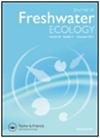Spatial and seasonal dynamics of phytoplankton groups and its relationship with environmental variables in Lake Okeechobee, USA
IF 1.3
4区 环境科学与生态学
Q3 ECOLOGY
引用次数: 5
Abstract
Abstract The concept of phytoplankton functional groups was used to assess phytoplankton community structure in an attempt to better understand their spatial and seasonal variation in Lake Okeechobee, USA. Samples were collected for analyses during summer and winter. 23 phytoplankton functional groups were identified among 102 species, of which 9 groups (H1, M, C, MP, Y, S1, J, X1 and X2) were categorized as dominant. Y represented by Cryptomonas ovate and H1, represented by Anabaena circinalis and Anabaena variabilis, were dominant in some sites in summer corresponding to higher temperatures. In winter, the biomass of the functional groups was dominated by chlorophyta group X2 corresponding to lower temperatures, and relatively high nutrients. Redundancy analysis (RDA) with Monte Carlo test revealed that water temperature (WT), TP, and TN were the most dominant environmental variables which influenced phytoplankton functional group distribution in Lake Okeechobee. Functional group H1 was associated with TN, pH, TP and WT. Similarly, functional group Y was significantly positively correlated with TN, TP and WT but negatively correlated with TN/TP ratios. This study reveals the importance of physical–chemical variables across a spatial and seasonal gradient, in structuring phytoplankton functional groups, and consequently in the assessment of environmental status of the lake.美国奥基乔比湖浮游植物群落的空间和季节动态及其与环境变量的关系
摘要采用浮游植物功能群的概念对美国奥基乔比湖浮游植物群落结构进行评价,以期更好地了解其空间和季节变化。在夏季和冬季收集样本进行分析。102种浮游植物共鉴定出23个功能类群,其中优势类群为H1、M、C、MP、Y、S1、J、X1和X2 9个。以卵形隐单胞菌(Cryptomonas ovate)为代表的Y和以环状水芽胞菌(Anabaena circiralis)和变型水芽胞菌(Anabaena variabilis)为代表的H1在较高温度的夏季部分地点占优势。冬季,各功能群的生物量以温度较低、养分含量较高的绿藻群X2为主。冗余分析(RDA)和蒙特卡罗检验表明,水温(WT)、TP和TN是影响奥基乔比湖浮游植物功能群分布的最主要环境变量。功能组H1与TN、pH、TP和WT呈正相关,功能组Y与TN、TP和WT呈显著正相关,与TN/TP呈负相关。本研究揭示了跨空间和季节梯度的物理化学变量在构建浮游植物功能群,从而评估湖泊环境状况中的重要性。
本文章由计算机程序翻译,如有差异,请以英文原文为准。
求助全文
约1分钟内获得全文
求助全文
来源期刊
CiteScore
2.20
自引率
7.70%
发文量
34
审稿时长
3 months
期刊介绍:
The Journal of Freshwater Ecology, published since 1981, is an open access peer-reviewed journal for the field of aquatic ecology of freshwater systems that is aimed at an international audience of researchers and professionals. Its coverage reflects the wide diversity of ecological subdisciplines and topics, including but not limited to physiological, population, community, and ecosystem ecology as well as biogeochemistry and ecohydrology of all types of freshwater systems including lentic, lotic, hyporheic and wetland systems. Studies that improve our understanding of anthropogenic impacts and changes to freshwater systems are also appropriate.

 求助内容:
求助内容: 应助结果提醒方式:
应助结果提醒方式:


